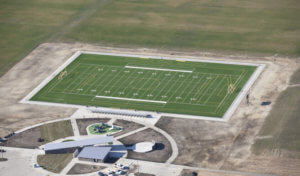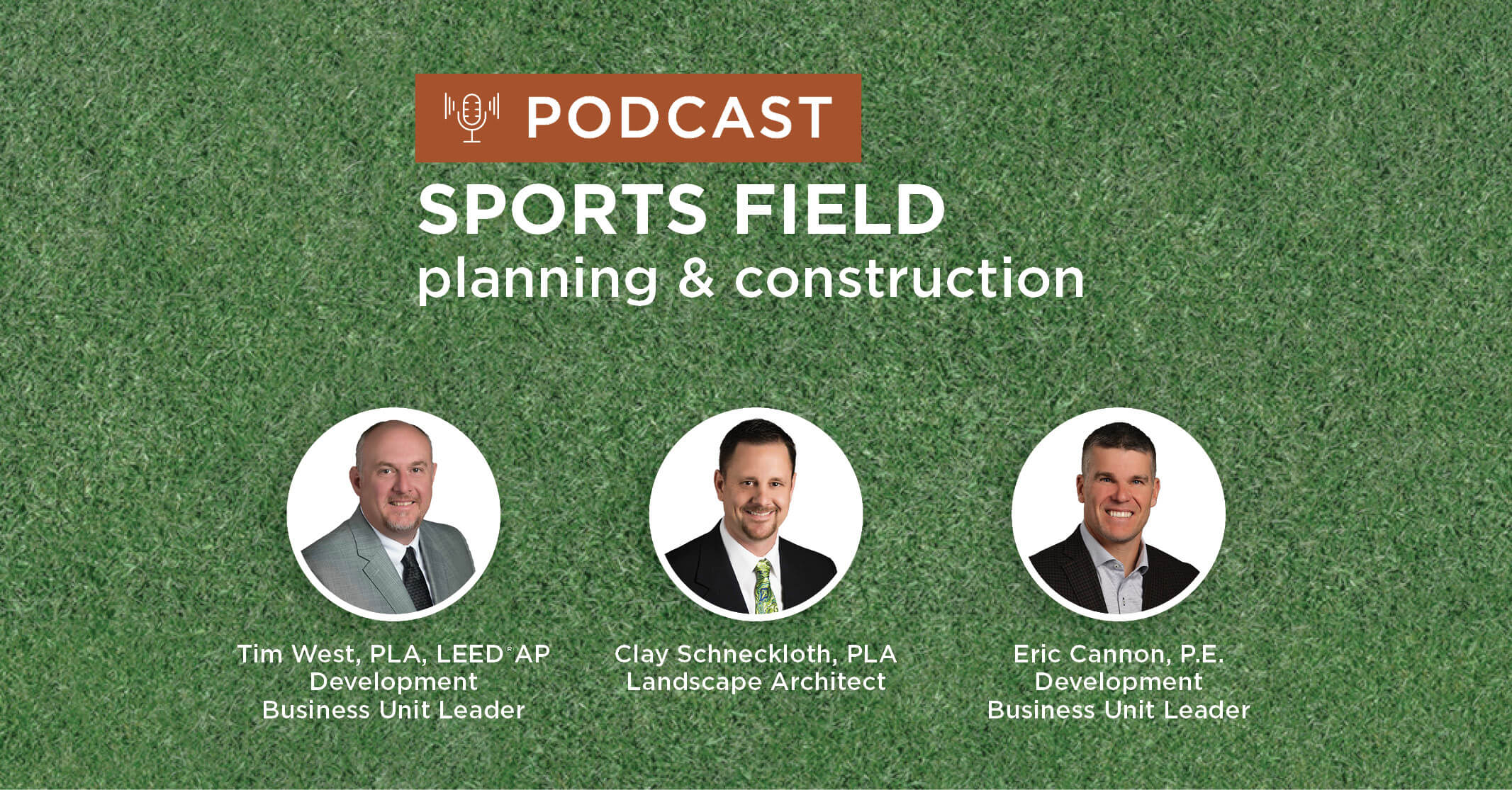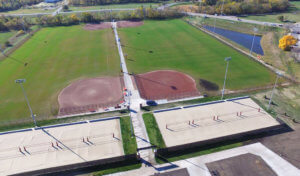Sports Field Planning & Construction Scheduling Process
In a short timeframe, there are countless deadlines and schedules to be managed, contractors to coordinate, and safety and compliance regulations to be followed. A seamless effort requires a seasoned leader who understands what it takes to navigate a professional construction project to a successful end.
Every sports field construction project, regardless of its complexity, requires a professional level of project management. During this podcast, Clay Schneckloth, PLA with Snyder & Associates, shares details on the sports field planning and construction scheduling process. From irrigation and drainage to turf and amenities, several factors go into designing a state-of-the-art sports complex, and each selection affects the timing of construction. View a sample schedule and gain insights to improve the planning and design process.
Podcast Agenda
- Outline of Sports Field Construction Schedule (0:19)
- Optional Sports Field Amenities Affect Scheduling (3:08)
- Cost Estimate Planning (5:45)
- Material Selection: Sod Versus Seed Establishment & Maintenance (7:43)

Tim West, PLA, LEED®AP
Development Business Unit LeaderTim West, PLA, LEED®AP
Development Business Unit LeaderMaster Planning, Project Management, Athletic Design, Park Design, Public Engagement

Clay Schneckloth, PLA
Landscape ArchitectClay Schneckloth, PLA
Landscape ArchitectParks and Recreation Design, Sports Fields Design, Green Infrastructure and Native Plantings, Landscape Design

Eric Cannon, P.E.
Development Business Unit LeaderEric Cannon, P.E.
Development Business Unit LeaderSubdivision and Site Development Engineering, Stormwater Modeling, Master Planning, Municipal Engineering, Construction Assistance
Outline of Sports Field Construction Schedule

Construction scheduling plays a big role in new facility development as it has to work around sports seasons.
Clay Schneckloth (0:19)
We’re going to talk a little bit more about some public projects, but dealing mostly with cities and schools. When we’re dealing with sports field construction—baseball, softball, football, soccer, tennis, track—when I say field, it could be a reference to any one of these items. A lot of times, these projects are one-season construction-type projects. We’re working with the city where there’s a rec program, where we’re looking to maybe put a tennis court, baseball, or softball field into their city to expand their recreation program. With schools, we’re looking to expand their athletic programs. Maybe they have an existing baseball field that they like to renovate or maybe a new football field completely.
I’ll hit on the school portion of it here first. Most of it’s the athletic directors or school boards; they know they want a new field or to renovate an existing one, then we just start the timing discussions with them. One of the big questions that we want to bring up and ask is, “When do they want to play on this field?” When we’re talking with the athletic directors or school boards, it’s “Hey, we want a new baseball field, and we want to have it out there next spring to play on.” There are a lot of things that go into it to be able to make it happen by that next spring, and we’ll try and go over a couple of those items here.
For most of our projects, the construction needs to be completed between mid-May and August. We really have a limited construction window when we’re working with athletic programs at schools. A lot of these schools are limited in the amount of space that they have or the fields that they have. We typically don’t have an event over the summer months, so that gives us the window to build and construct these items. Spring sports last until the end of May. Fall sports basically start at the end of August. That gives us that window between May and August to start and build a lot of these fields and projects.
A lot of times, we’d like to try and bid on the project early in the construction year, if possible: January, February, or even into March. We really do like to see 12 to 16 weeks for the design process and approval time to be able to build these fields over the summer months.
A sample schedule might be as follows:
- Topographic Survey – August
- Begin Design – August or before
- Design – August, September, October, November
- Geotechnical – To be completed in the fall, before winter
- Receive Approvals – December
- Bid Opening – January
- Begin Construction – Following Spring
Eric Cannon (2:34)
What’s the difference between renovating an existing field or a facility and building a new one?
Clay Schneckloth (2:39)
The big difference is that if we’re building a new field, we may not have to wait for a season to get over. It’s all about the timing of the construction.
If we have to renovate an existing one, we may need to wait until that sport is completed. Let’s say it’s a baseball field that we want to renovate, and they just have one field to play on. We may need to wait until the end of spring-summer before we can start the demo and construction, getting it ready for the following year.
Optional Sports Field Amenities Affect Scheduling
Tim West (3:08)
When would you target any fieldwork or any type of information gathering on what they already have at the property or project site?
Clay Schneckloth (3:18)
You bet, yeah. When we first get the call or have that discussion with the athletic director or the buildings and grounds director, even the school board member, their question is, “Hey, we’d like to try and do a new field.” Then, we would have an initial conversation to start asking some of these questions to go over timing. Some of those questions that we’ll bring up and discuss are access to the field. If we’re looking to try and renovate an existing football field and we’re going to try and do it over the summer months, we need to wait until spring track is over. A lot of times, there’s a track running around the outside of these. To get access onto the football field, we need to wait for spring track to be finished to be able to get in there and start working on the football field.
Another question that we’ll bring up is some utility concerns. Is there electric, water, storm sewer available on-site? That definitely affects the budget and definitely affects the schedule if we need to work on trying to get storm sewer brought into the site or into where our proposed renovations are going to be.
Buildings, architecturally, are we going to need to incorporate a concession building and a restroom building? Those are all great amenities that we’d like to try to incorporate with a lot of these sports fields, and a lot of times, they are included. We need to make sure that we’re bringing in the correct design team and architectural, mechanical, and electrical plans – get those incorporated into the project, too.
Sports field lighting, that’s another component that we like to try and bring up and ask too – if we need to bring in a specific field lighting package for this project or if it’s going to be just more of a rec field without field lighting. That definitely affects the construction schedule. Also, when we’re dealing with specific products, Tim, you’ve dealt with a lot on synthetic turf fields that there’s a temperature-sensitive product that you like to try and get installed.
Tim West (5:05)
Yeah, we usually have some trouble with different types of adhesives on a lot of the specialty surfaces associated with sports fields. For example, the synthetic turf sections are usually held together with a combination of sewing and adhesive. Tracks are constructed of poured polyurethane, and nighttime temperatures need to be over a certain value, and we have to have four days or so to install that track surfacing where there is relatively good weather and relatively warm weather. So you can’t install those things too early in the year, and you can’t install too late in the year. Those have to be taken into consideration when you set your schedule as well.
Cost Estimate Planning
Tim West (5:45)
One thing that we’ve noticed and started to carry in our cost estimates is a contingency for installing that fly ash, particularly for a track or a synthetic turf field. A lot of times, we’ll have a wet spring, and there’ll be other work associated with the project that we start to get into June, and we still haven’t put down the rock base for the project. We use the 4th of July as a critical progress date that if we haven’t started putting the base rock down for either the track or a synthetic turf field, we start to have that conversation about whether we should invest in a fly ash treatment to allow us to continue work. If we have that carried as a budget item and the owner is aware of the possibility of spending that money ahead of time, it’s usually not that big of a deal.
If you don’t alert the owner to that, it can be a significant surprise. An athletic field can be $80,000 to $100,000 in additional costs if you want to fly ash the entire field and get it stabilized. It’s an item that we like to talk about upfront and include in our bidding so that there’s not a surprise because usually, on the tail end, we don’t have a lot of flexibility on when that field can be completed. A lot of times, we’re trying to get it done before the end of August for a football game that really can’t be moved or would be really difficult to move more than one or two of those.
Eric Cannon (7:07)
So in your circumstances, a lot of times, time is more important than money. You’ll overpay, or pay a premium for something, to meet a schedule?
Tim West (7:15)
Correct. I mean, no one likes surprises, so it has to be in the budget and well-defined, but I would say that’s very true.
Clay Schneckloth (7:22)
Yep, time is a concern. One of the bigger questions is, “Can a field be out of commission for one season?” A lot of times, the school districts don’t have the opportunity to play on an alternate baseball field or an alternate football field. We need to be able to renovate that existing field by the time one season ends and the next season starts is very critical.
Material Selection: Sod Versus Seed Establishment & Maintenance
Eric Cannon (7:43)
Will that dictate if you’re using sod versus seed in a lot of circumstances relative to the playing surface on those kinds of facilities?
Clay Schneckloth (7:50)
Very much so, yes, indeed. The seeding dates are very critical when we start looking at installing a field and wanting to seed it. We recommend one year’s worth of growth on the seed to get it established before you start playing any events on that field. We’ve noticed if you play on it earlier, it has a great detriment to the health and the establishment of that turf field. It is possible; you just have to have a very highly extreme program to help get it established.
Tim West (8:23)
That extreme program probably costs additional money in fertilizing and water, etc.?
Clay Schneckloth (8:30)
Yes, it does. It’s a daily item where you’re going to have somebody on staff out there, either fertilizing, aerating or seeding. Every day, there’s something that needs to happen if you want to try and play on it before that one year.
Tim West (8:44)
So, is that where sod could become an option?
Clay Schneckloth (8:48)
Sod is the option if you do not have one year’s worth of growth to establish, and you cannot take a field out of commission for one season.
Typically, I’d like to try and recommend having that sod installed by the end of May. Most of the time, we try and see two months of that sod being installed to get it established for maybe a fall sport. If we get it in by the end of May, that gives us June and July to get it established. A lot of times, football starts in the middle of August, and that can be a safe playable surface at that point.
Tim West (9:21)
In order to put sod down, you have to have a fully operational irrigation system, and sod can be pretty expensive.
Clay Schneckloth (9:29)
Yes, it definitely is more expensive than seeding, but that comes back to that conversation of – can that field be out of commission for that one season if we’re going to seed it, or do we have to play on it the very next season? When we’re having that discussion, we also want to try and make sure we have the talk of, is there a backup plan. What if the field isn’t completed in time? Is there an option to adjust the home versus away games on that upcoming season for maybe a few weeks? Is there another field that we can play on?
It’s better to have that conversation early on during the design process, then all of a sudden, a month before the season starts, the field isn’t ready, and everybody’s scrambling and trying to figure out something. Let’s have a backup plan already discussed and in progress so we know what we can do if all of a sudden the weather turns on us and it isn’t allowing us to complete that project in that specified time.
Watering and maintenance during the establishment period is a key factor that we want to try and make sure we understand, whether it’s by the contractor by the owner. It affects the budget and also the schedule. If we are having the contractor water and maintain that, it definitely adds to the budget. A lot of times, the school districts may not have the staff to be able to help get that field ready before that season. They may have the ability to get out there and mow it and do some aeration, but establishing that turf is more than just getting out there and mowing it.
Tim West (11:01)
We’ve found some situations where it needs to be clearly communicated between the contractor and the owner on those maintenance procedures as well. It’s not necessarily good enough to water it every once in a while. There has to be a specific plan established that either the contractor or the owners realize that they’re solely responsible for that operation and maintenance.
We’ve seen some cases where they’ve moved the responsibility to the owner too soon, and there can be some detriment to the way the turf gets established, or there could be some hard feelings between the contractor and the owner at the end of the project when things are trying to be wrapped up and closed in a positive way.
Clay Schneckloth (11:43)
We definitely want to make sure there’s a maintenance program set up after the field’s constructed. Everybody’s excited. It looks great. The contractors finished up and completed all the punch list items and are ready to walk away. It’s a big endeavor to take over a sports complex, a field, whatever it might be. We want to make sure we have that conversation with you on what the next step is and how you’re going to maintain this great amenity that you’re able to provide for either the school or the community.
Tim West (12:10)
If I’m an athletic director and want to build a field over the next couple of years, you’d recommend that I contact you at least in the early fall of the previous year to start the schedule discussion and identify timeframes for construction?
Clay Schneckloth (12:26)
Yep, let’s talk sooner rather than later. Let’s get that conversation going so we can at least get a schedule set up for you so that you understand when things need to happen.

